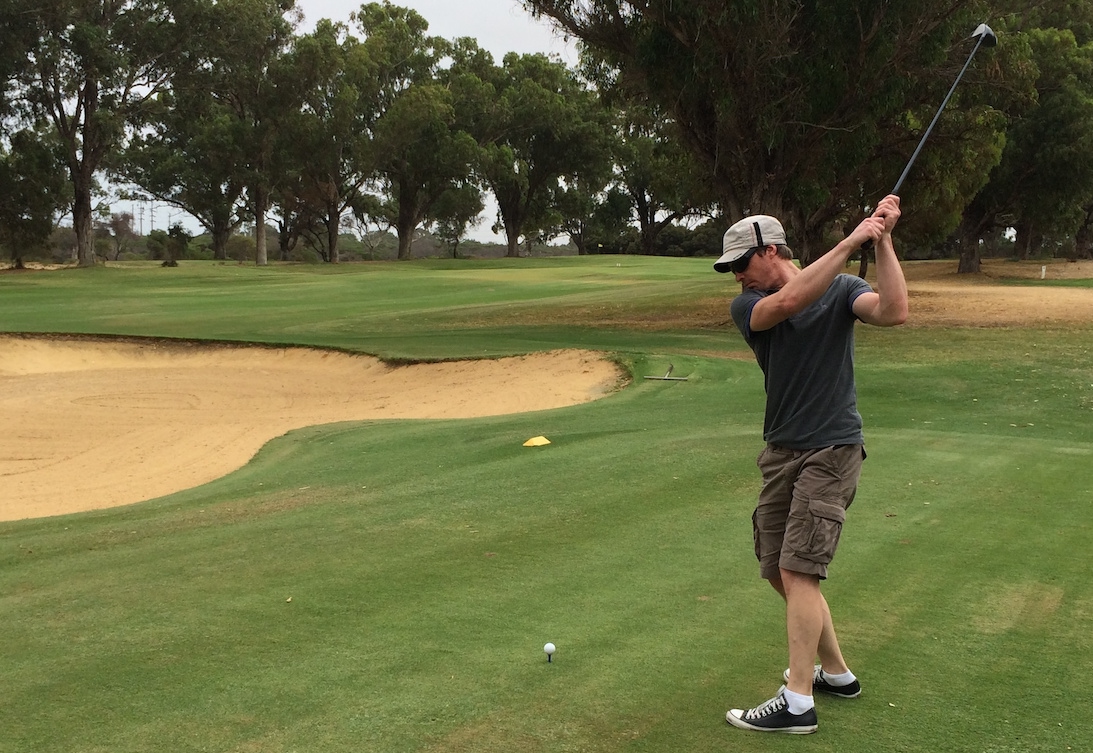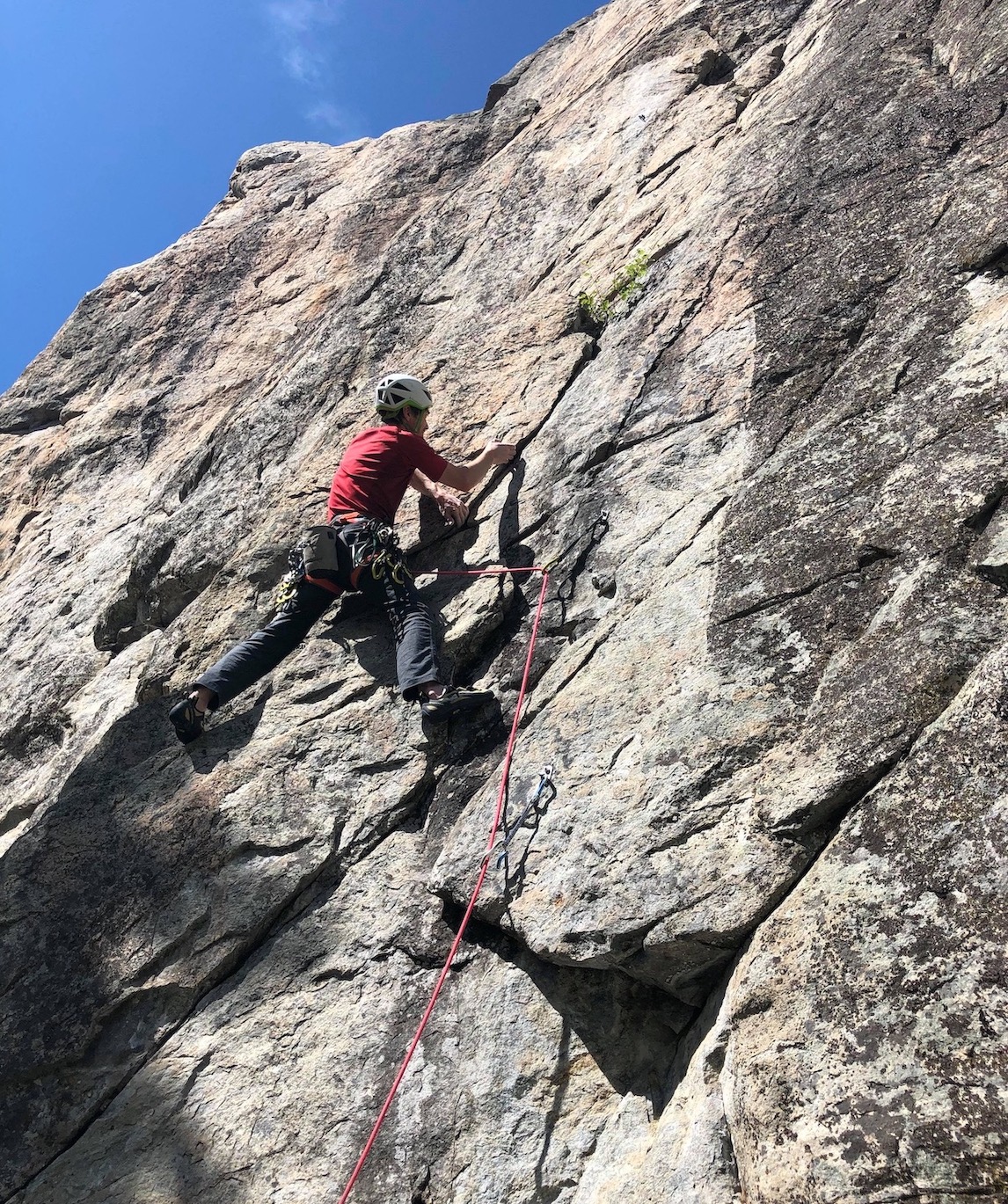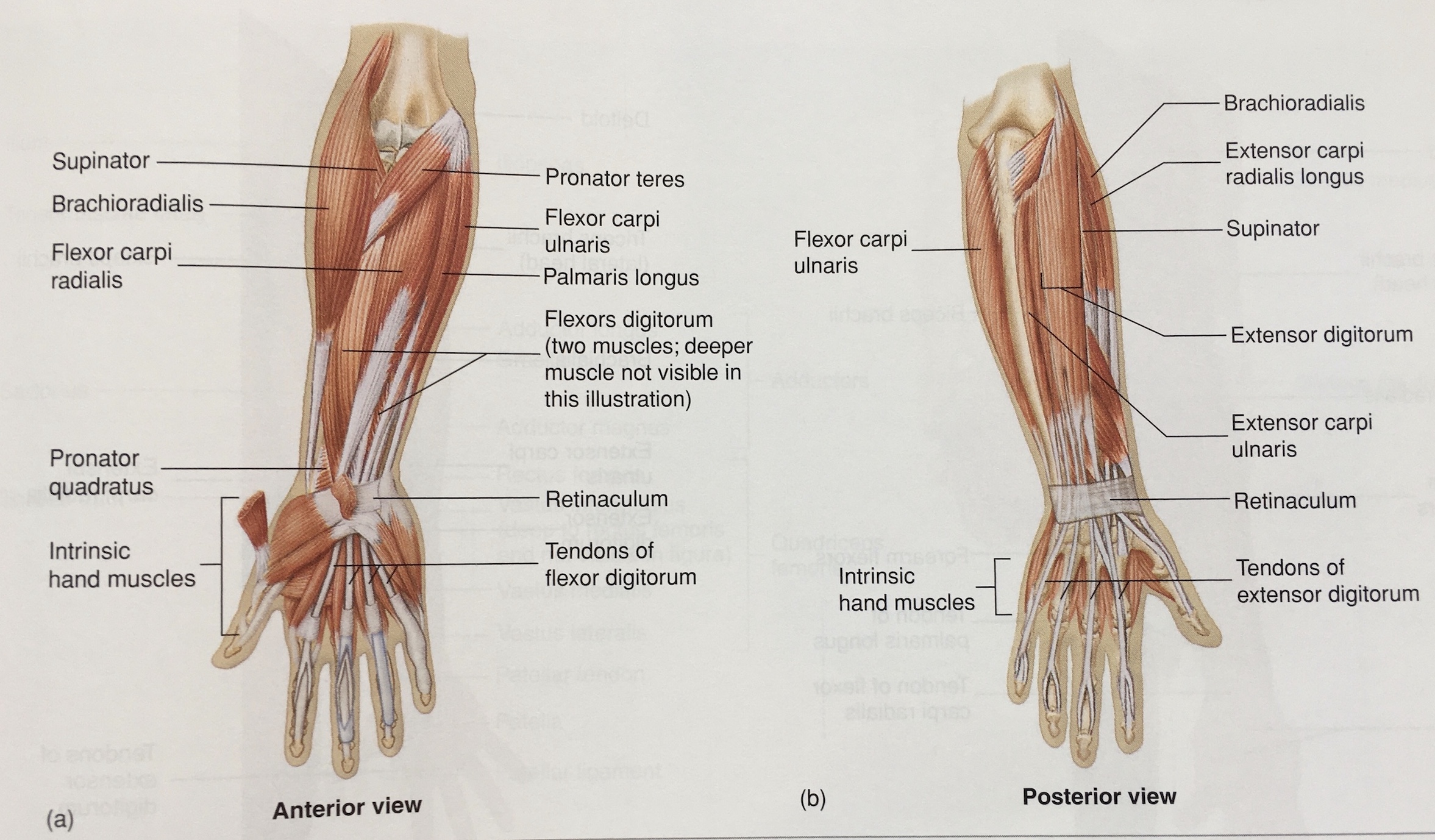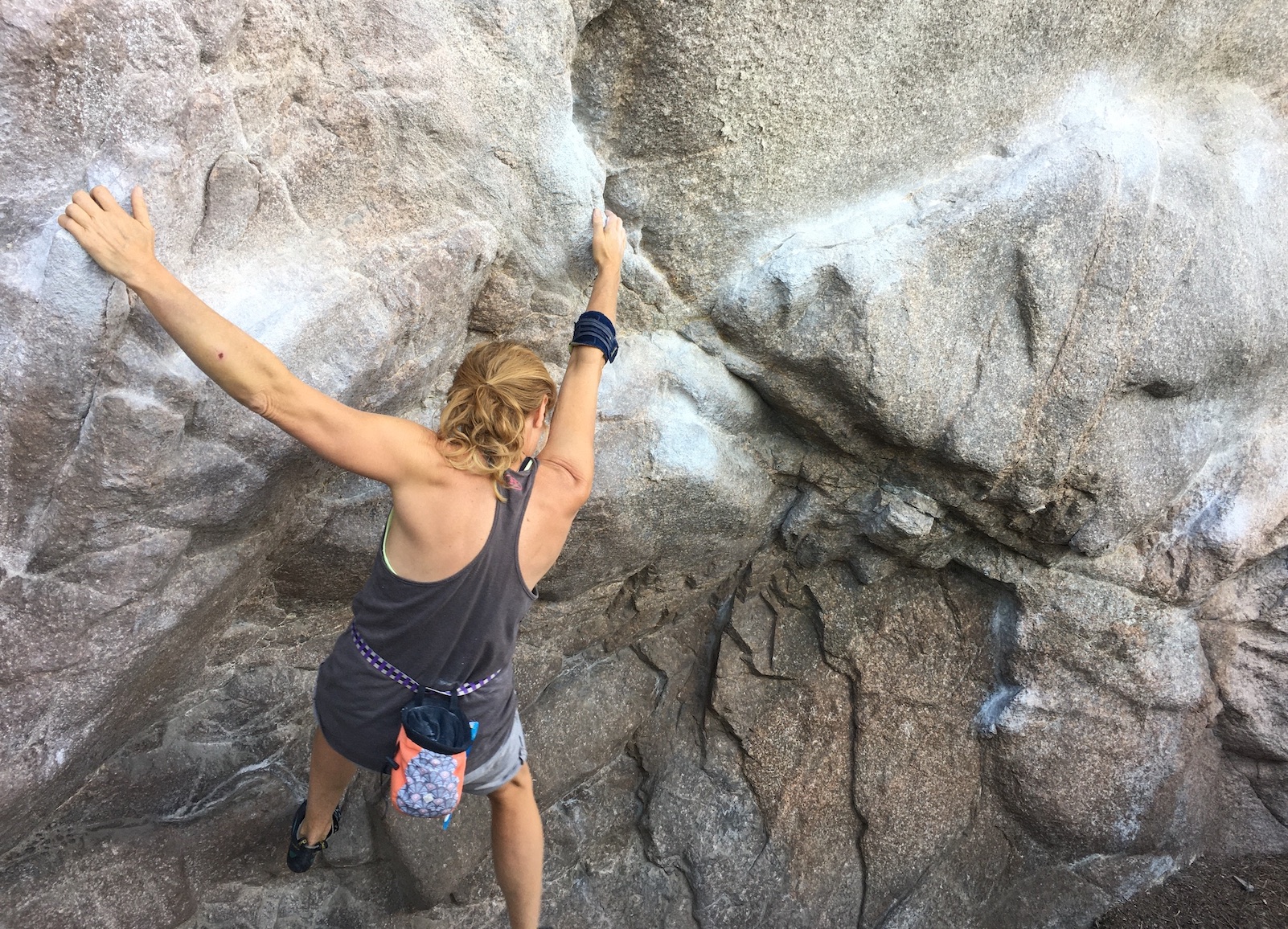Get a grip
Pilates prehab for common forearm injuries
Calling all golfers, tennis players, rock climbers and anyone else who uses their forearms for a living or recreation. Trades people and contractors – yeah, I’m looking at you too.

Golf involves repetitive gripping with rotation.
If you haven’t already had to deal with lateral or medial epicondylitis in your professional or athletic career, well, consider yourself lucky, but also know it’s only a matter of time before you do…without the appropriate intervention, of course.
This common condition, also known as tennis elbow and golfer’s elbow (go figure), can afflict anyone who uses (and abuses) their wrists, forearms, and elbows through long-term repetitive activity. In fact, my physio friend says she treats one of these cases in her clinic every day or two.

A climber uses his hands and forearms to hold on to the rock in a variety of different ways.
In their book One Move Too Many: How to Understand the Injuries and Overuse Syndromes of Rock Climbing, page 76, Volker Schoeffl, Thomas Hochholzer, and Sam Lightner Jr, state that:
“Elbow pain is a plague on climbers. The most common forms of elbow pain are tennis elbow (lateral epicondylitis) and golfer’s elbow (medial epicondylitis) but there are other problems that can occur in the elbow.”
But don’t despair just yet. I’m here to tell you that you can continue doing what you love pain free, whether it’s your job or your sport, by spending just a bit of extra time being proactive about injury prevention and rehabilitation through some fun and rewarding exercises.
Before I give away all my secrets, let’s go over lateral and medial epicondylitis in a little more detail.
Epi…what?
Lateral and medial epicondylitis are acute conditions affecting the tendons in the elbow, albeit slightly different ones.
In severe cases, or if left untreated, these conditions can become chronic at which point they’re called epicondylalgia. But for now, let’s focus on the ‘itis’, which is really just medical jargon for ‘inflammation’.
While lateral epicondylitis is associated with repetitive contraction or overuse of the wrist extensors and continuous gripping with wrist and elbow motion, medial epicondylitis results from repetitive contraction and overuse of the wrist flexors. There may also be microtears or fraying of the tendon. Sounds painful, right?

Anatomy of the hand and forearm. Source: VanPutte, et al. (2016) Seeley's Essentials of Anatomy and Physiology, Ninth Edition.
It is. Symptoms include pain or tenderness either on the outer side of the elbow (lateral epicondylitis) or inner side (medial epicondylitis), weak grip, and pain when gripping, lifting or rotating.
Of the two, golfer’s elbow tends to be less common; however, both conditions are often associated with issues higher up in the arm, shoulder, neck, and even torso, where there may be other dysfunctions, imbalances or weaknesses.
How do I prevent it?
With prolonged overuse (or underuse) of certain muscles, tendons, and joints, our bodies can go a little bit wonky. Out of whack, so to speak. Unbalanced. When this happens, we start feeling discomfort and soreness, and eventually, pain and injury.
In the case of rock climbers, the imbalances are strikingly clear:
“Almost all patients suffering from tennis elbow (lateral epicondylitis) have a short and less developed extensor group. Initial treatment for mild cases of tennis elbow is stretching and developing the extensors. If the extensors cannot be stretched through therapy then it is unlikely the pain will recede. This is one more piece of proof that stretching and developing both muscle groups is necessary to maintain good health.” (Schoeffl, Hochholzer, and Lightner Jr., page 76)

This climber underwent shockwave therapy to treat lateral epicondylitis. She now wears a band over the previously affected tendon to stabilize it while climbing.
There is no magic pill for total body health but one of the most effective ways of working out these kinks and keeping the body in balance is Pilates.
Developed more than 80 years ago by German-born Joseph Pilates, Pilates is a comprehensive and integrated total body fitness method that uses the mind-body connection to develop strength, balance, and flexibility, with specific focus on the core muscles – the ‘powerhouse’ of the body.
According to SportMedBC, Pilates “is being used by athletes involved in many different sports to help them enhance athletic performance, improve technique and prevent injuries”.
In fact, Pilates’ original clients were dancers and performers looking to keep their physique in top shape and gain that competitive or artistic edge.
By focusing on functional movement, proper breathing, working muscles both statically and dynamically, and optimizing alignment, Pilates is the perfect complement to pretty much any sport or physically demanding profession.
How do I get rid of it?
Even with the best intentions, however, you may still one day end up with epicondylitis, or potentially some other unforeseen injury. In which case, it’s not game over. Pilates is now often recommended as part of a therapeutic program for those recovering from injury.
Treatment for epicondylitis would initially include stretching the wrist flexors and extensors (did you know that a healthy wrist should be able to flex and extend, with the fingers extended, 90 degrees?), exercises with no or minimal weight bearing on the wrist until it is pain free, stabilization exercises for the elbow and shoulder, mobilization of the spine and torso, and continuous focus on strengthening the abdominals.

Healthy wrist flexion.

Healthy wrist extension.
Samantha Wood explains what this looks like for a tennis player in her book, Pilates for Rehabilitation (pages 27-28):
“A strong, optimally functioning body must be both stable and mobile. Adequate stabilization proximally enables us to attain optimal function distally. Take, for example, a tennis player: he must have proximal strength and stability of his shoulder girdle, yet tremendous mobility in the arm to be able to efficiently hit the ball. If the shoulder is weak or unstable it is likely that an injury will occur over time. The common tennis injury lateral epicondylitis, or tennis elbow, is often caused by late strokes and "wristy" impact due to a lack of scapular stability, which places too much stress on the elbow and wrist joints. One of the ways we treat this is to strengthen the muscles of the arm, shoulder, and upper back to help take stress off of the elbow. Can we do this with Pilates exercises? Absolutely! However, if the shoulder girdle is so stable that it doesn't move, it is not possible to raise the arm overhead into the proper position to deliver a powerful serve. Thus, exercises that mobilize the shoulder complex are also important, and there are many of these in the Pilates repertoire as well.”
And if you’re still unconvinced, there is an ever-growing body of research showing that doing Pilates can benefit not just the general population, but specific conditions and pathologies as well.
(FN1) A study from 2009 looking at the effect of a Pilates training program on arm-trunk posture, strength, flexibility and biomechanical patterns during a functional shoulder flexion task found that the program was effective in improving the abdominal strength and upper spine posture of the study participants as well as stabilizing their core posture as they performed shoulder flexion movements. Since deficits in these functional aspects have previously been associated with symptoms in the neck-shoulder region, the results support the use of Pilates in the prevention of neck-shoulder disorders.

Trades people and contractors are also susceptible to epicondylitis.
So, whether you’re a golf pro, tennis star, weekend warrior rock climber, or professional who relies on their hands and arms to make a living, Pilates may well be your secret weapon to a long and healthy career. What are you waiting for? Get a grip!
FN1: Emery K, De Serres SJ, McMillan A, Côté JN. The effects of a Pilates training program on arm-trunk posture and movement. Clin Biomech (Bristol, Avon). 2010 Feb;25(2):124-30. doi: 10.1016/j.clinbiomech.2009.10.003. Epub 2009 Oct 30. PMID: 19879677.
Anna Belodedenko is a Pilates instructor-in-training and rock climber.